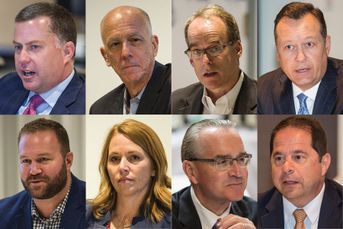3 drivers of transformation point to ways financial advisers can master digital age
The following is an edited excerpt from “FinTech Innovation: From Robo-Advisors to Goal Based…
The following is an edited excerpt from “FinTech Innovation: From Robo-Advisors to Goal Based Investing and Gamification” by Paolo Sironi (Wiley, 2016). Mr. Sironi is a global thought leader for wealth management and investment analytics at IBM.
Financial advisers are a very influential factor in the makeup of investors’ portfolios, as they sit at the forefront of the wealth management relationship and are asked to advise clients through the cycle on a broad range of goals related to their financial well-being. According to a recent study on Canadian households’ portfolios by Foerster, Linnainmaa, Melzer and Previtero (2014), advised clients take statistically more risk in their asset allocations, thereby raising expected returns, although there seems to be limited evidence of customization.
Advisers seem to direct clients into similar portfolios independent of their clients’ risk preferences and stage in the life cycle. Social trends are demonstrating that personalization is becoming progressively relevant to younger generations and thus must be embedded within the full advisory experience for advisers to stay competitive. Therefore, the main challenge they face is to find the right balance between a progressive commoditization or robotization of portfolio management and a high perception of personalized advice. All for the right fees! Individuals are truly becoming more comfortable managing their wealth online, but they also need to be guided through a process of self-directed customization.
The synthesis of these conflicting desires can be termed empowered customization, which means being guided through the investment decision-making process instead of being taught about it. Both robo-advisers and personal financial advisers are competing in this space. If you cannot beat them, join them.
Hence the rise of robo-4-advisers, which aim to create a new professional being: the digital-adviser or cyborg, as many commentators like to call it.
(Related read: Fidelity’s robo for financial advisers will give clients eMoney tools)
The advantages of merging personal advice and robo-technology are not limited to portfolio management and profiling, but extend to prospecting. Individuals increasingly rely on social media and peer-to-peer recommendations to learn investment ideas and trust relationships, instead of their being passed on from father to son. Therefore, old-school advisers will suffer the most, as they find it difficult to reach out in a digital world, while younger and techno-literate professionals could exploit new technology to their advantage by penetrating communities of potential clients by means of social media networking.
VERTICAL INTEGRATION
Digital-advisers could therefore benefit from the vertical integration offered by robo-4-advisers or new robo-platforms, thus outsourcing the building blocks of portfolio rebalancing to robo-solutions and freeing up valuable time for “gamma tasks”: social media relationships, blogging, onboarding of new customers, walking clients through their life cycle, and proactively engaging with their evolving ambitions, risk tolerances and multiple financial goals. Three drivers of transformation affect the practices of personal financial advisers and three recommendations can be given to master digital change: Focus on the generational divide, have a digital life, and take care of retirement.
First, master the generational shift. Wealth is about to change hands as baby boomers retire and de-cumulate from their investments or pass them to younger generations. This creates a divide between the approach and fate of financial advisers because new generations are more likely to change their provider of financial advice than older cohorts. According to a study by Cerulli Associates (2013), 43% of U.S. advisers are over 55. As baby-boomer advisers are servicing a more mature population, they might not feel compelled to embrace change as they themselves are approaching retirement. New entrants can grab this chance and target both inheritance money as well as the new generation of HENRYs (high earning, not rich yet).
Second, have a digital life! Robo-technology allows verticalization of the wealth management workflow for small firms, facilitates faster onboarding of prospects, offers recognized digital branding and adds efficient digital dialogues with final investors. Although first adopters of robo-advice seem to come from the pool of already self-directed investors, more than personally advised assets under management, fintechs are posed to attract a much larger portion of advised AUM by competing with those professionals who are not embracing modern CRM competences.
(Related read: To help clients succeed in investing, it may require a walk down bizarro Wall Street)
Therefore, embedding robo-4-advisers within human advice saves time from red tape and routine, and allows more focus on gamma tasks to retain customers, improve reporting, justify advisory fees and optimize cost/income. Advisers can learn to write blogs to become relevant and share content with their clients and prospects in ways that are more relational and less prescriptive. Clients might appreciate learning what others do more than being told what to do. Digital presence gives advisers the means to stay relevant, but also prove their propositions by crafting social media nudges.
Third, take care of retirement! The wealthy population has been aging fast; life after retirement has been extending favorably, while government finances have been exposed to unprecedented stress. Taxable investors are becoming more aware that government-sponsored schemes might not be enough to sustain their purchasing power during their golden years, while retirement plans linked to the dynamics of financial markets have led to excessive exposure of investors’ nest eggs to the financial cycle.
VISUALIZE THE IMPACT
This is creating a broader request for personal advice on long-term investing, which is typical of financial planning solutions, but requires higher competences of financial markets, which is typical of financial advice. Digital technology and gamification offer solutions to visualize the impact of investment decision-making in the long term, which human advisers should embrace to enrich clients’ decision-making.
Due to the behavioral and psychological complexities of managing holistic discussions with individuals and families about long-term financial planning, digital-advisers seem to have a competitive advantage compared to self-directed offers as long as their pricing point is attractive. Financial advice and financial planning can converge to forge a very competitive workforce of independent digital-advisers.
Learn more about reprints and licensing for this article.








